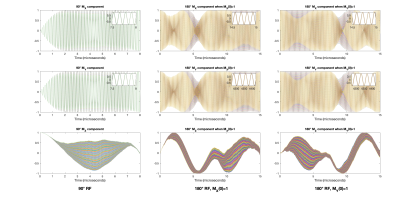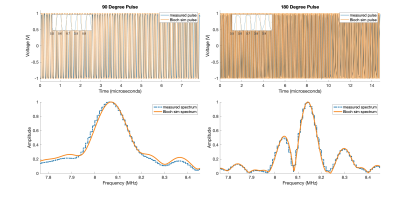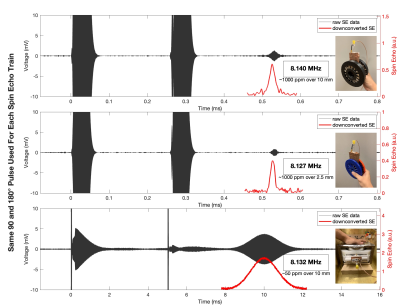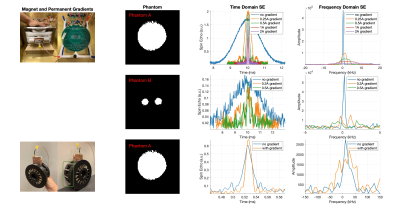1131
Bloch-Optimized Dithered-Ultrasound-Pulse RF for Low-Field Inhomogeneous Permanent Magnet MR Imagers
Irene Kuang1, Nick Arango1, Jason Stockmann2,3, Elfar Adalsteinsson1,4, and Jacob White1
1Electrical Engineering and Computer Science, Massachusetts Institute of Technology, Cambridge, MA, United States, 2A. A. Martinos Center for Biomedical Imaging, Massachusetts General Hospital, Charlestown, MA, United States, 3Harvard Medical School, Boston, MA, United States, 4Institute for Medical Engineering and Science, Massachusetts Institute of Technology, Cambridge, MA, United States
1Electrical Engineering and Computer Science, Massachusetts Institute of Technology, Cambridge, MA, United States, 2A. A. Martinos Center for Biomedical Imaging, Massachusetts General Hospital, Charlestown, MA, United States, 3Harvard Medical School, Boston, MA, United States, 4Institute for Medical Engineering and Science, Massachusetts Institute of Technology, Cambridge, MA, United States
Synopsis
Declining costs of permanent magnets and embedded systems electronics has driven systems engineering of point-of-care diagnostics to the forefront of MR research. We present a low-cost RF signal chain (<$100) for low-field imaging using a Teensy 4.0 microcontroller and STHV800 ultrasound pulser IC. Bloch-optimization simulation of programmable, dithered-pulses enables broadband excitation of the notably inhomogeneous permanent magnets employed in portable, hand-held MR systems.
Introduction
The complex infrastructure needed for high-field MR scanners has relegated this very safe, and remarkably revealing, clinical tool to high-end hospital care. But for many potential applications of MR, point-of-care diagnostics, routine screening or classroom experimentation, image quality is far less critical than portability and low cost. Emphasizing cost and portability over image quality has led researchers to focus on low-field MR, of the order of tens to hundreds of millitesla, generated using arrays of inexpensive permanent magnets.1-3 In this paper, we describe our approach to achieving a commensurate cost reduction in the RF subsystem, while still generating RF signals needed for the higher B0 inhomogeneity associated with magnet arrays. We propose a low-cost (<$100) signal chain consisting of a Teensy 4.0 microcontroller and 8-channel STHV800 ultrasound pulser chip. The Teensy's ARM Cortex-M7 processor can generate pulses with a timing resolution of 3.3ns that the ultrasound pulser can drive transmitter coils. We use MATLAB’s genetic algorithm to optimize broadband 90 and 180° RF pulses based on solving the Bloch equation, and demonstrate these tools in our spokes-and-hub permanent magnet.4Methods
Ultrasound and low-field MR share a similar range of center frequencies (1-8MHz), but thanks to the large portable-ultrasound market, there are a number of low-cost ICs for generating ultrasound pulses. For example, we used the 8-channel STHV800 ultrasound pulser ($30, STMicroelectronics) to create programmable, high-voltage pulses as well as receiving low-amplitude signals through its T/R switch. Because each channel is driven by 2 digital bits, the chip can be enabled by digital square-wave outputs. Teensy 4.0 ($20, PJRC), with its ARM Cortex-M7 processor and dynamic clock scaling functionality, allows for reliable generation of pulse width modulated (PWM) RF pulses. This allows for careful control of the RF output from the Teensy through amplitude and frequency modulation to created dithered-pulses. These two degrees of freedom, amplitude and frequency, can be easily modulated by adjusting duty cycle and period of square-wave oscillation on the microcontroller. This allows us to set up an optimization of 90 and 180° pulses to satisfy the Bloch equations over a specified bandwidth of frequencies. Given the limited number of degrees of freedom and short pulse durations required when driving at higher amplitudes, computing and optimizing a discrete time solution to the Bloch equation in the rotating frame can be done within minutes on a CPU using MATLAB’s constrained optimization genetic algorithm.From our Bloch simulation, we designed dithered-pulses optimized across a frequency band of 8.05 - 8.17MHz (~100kHz bandwidth). As shown by the transverse magnetizations, Mx and My in Fig. 1, the optimizer was able to produce well-aligned frequency isochrones for the 90 and 180° pulses. In the longitudinal direction Mz, for the 90° pulse, the simulated pulse was able to get all the frequency lines to converge at 0, and for the 180° pulse, the was able to produce the appropriate flip. Figure 2 shows that the simulated pulse and measurement from the Teensy output are in close alignment in both time and frequency.
With the Teensy generating gating and optimized Bloch RF pulses, these signals are modulated by the STHV800 ultrasound pulser for bipolar RF drive up to ±90V as detailed by the schematic in Fig. 3. We recorded spin echoes (SEs) in three permanent magnets with nominal B0 around 191 mT with center frequency at 8.13MHz. The magnets also covered a wide range of homogeneity — 50ppm homogeneity over 10mm from the MIT-MGH ‘tabletop scanners’, 1000ppm over 2.5 and 10mm from two different equivalent-charge-optimized ‘spokes-and-hub’ magnets.4,5
Results
With the signal chain described above, we have demonstrated the use of our broadband RF pulse in several permanent magnet topologies. Figure 4 shows that, when using the same excitation pulse on three magnets of varying B0 and homogeneity, reproducible SEs can be obtained from each magnet. A shorter echo time was used for the spokes-and-hub magnet due to the inhomogeneity within the magnet. The pulses can be used even when a permanent gradient is applied to the magnets during both excitation and readout (Fig. 5). For the tabletop magnet, we drove up to 2A on existing gradient coils from the setup to create the constant x-directed gradient field; in the spokes-and-hub magnets, additional bar magnets were placed along one side as shown in Fig. 5. The gradient produces broadening of SEs in frequency and narrowing in time. Since the spokes-and-hub topology is inherently less homogeneous than the carefully-shimmed tabletop magnets, when the permanent magnet gradient is applied, our 100kHz broadband RF pulse is indeed able to excite that bandwidth within the volume of fluid in the phantom. Furthermore, the spread-spectrum excitation can enable 1D-projection imaging as shown by the distinct frequency peaks when gradients were applied to the two separate tubes within Phantom B in Fig. 5.Conclusion
By using the Teensy 4.0 and STHV800 to produce Bloch-optimized dithered pulses, we have demonstrated a low-cost signal chain for broadband excitation of hand-held MR magnets that is forgiving to the large inhomogeneities within these magnets. Furthermore, with the 8 channels available on the STHV800 chip, there is an opportunity to explore avenues in parallel transmission or PWM drive of gradient coils.Acknowledgements
Funding support from NIH NIBIB R01EB018976, MIT-MGH seed grant, Skolkovo Institute of Science and Technology Next Generation Program, and MIT EECS department.References
- Wald LL, McDaniel PC, Witzel T, Stockmann JP, Cooley CZ. Low-Cost and Portable MRI. J. Magn. Reson. Imaging, 2019.
- Cooley CZ, Stockmann JP, LaPierre C, Witzel T, Jia F, Zaitsev M, Stang P, Scott G, Wenhui Y, Zheng W, Wald LL. Implementation of low-cost, instructional tabletop MRI scanners. Int. Soc. Magn. Res. Med., 2014.
- Cooley CZ, Stockmann JP, Armstrong BD, Sarracanie M, Lev MH, Rosen MS, Wald LL. 2D Imaging in a Lightweight Portable MRI Scanner without Gradient Coils. Magn. Res. Med., 2015.
- Kuang I, Arango N, Stockmann J, Adalsteinsson E, White J. Equivalent-Charge-Based Optimization of Spokes-and-Hub Magnets for Hand-Held and Classroom MR Imaging. Proc. Intl. Soc. Mag. Reson. Med. 27. 2019.
- Hugon C, D’Amico F, Aubert G, Sakellariou D. Design of arbitrarily homogeneous permanent magnet systems for NMR and MRI: theory and experimental developments of a simple portable magnet. J. Magn. Reson. Imaging, 2010.
Figures

Result of MATLAB genetic algorithm optimization of Bloch equations for dithered 90 and 180° pulses. Each line in the plots represents the Bloch magnetization curve of a particular frequency isochrone that was optimized over the duration of the pulse. The 180° pulse was optimized for initial conditions of Mx = 1, My = 0 and Mx = 0, My = 1. The inset plots in the Mx and My graphs show proper phase alignment of each frequency isochrone’s magnetizations at the end of the pulse.

90 and 180° pulses from Bloch simulation optimization (orange) with oscilloscope measurements (blue) in time and frequency domain. The broadband RF pulses were optimized for frequencies from 8.05 - 8.17 MHz. The respective 8 and 16 μs, 90 and 180° pulses, were used to generate spin echoes in portable, permanent magnets.

Signal chain block diagram. Teensy 4.0 microcontroller generates 3.3V gating and RF signals for the STHV800 ultrasound PWM driver. The ultrasound board produces bipolar RF pulses up to ±90V and obtains the received signal from the coil through its on-board, T/R switch. Up to 8 PWM channels can be driven with ±2A from the STHV800 chip for multi-coil transmit and receive as well as gradient drive.

Spin echoes acquired using the same 90 and 180° pulse for three permanent magnet topologies with different center frequencies (8.127 - 8.140 MHz) and imaging area homogeneities. The pulses shown in Figs. 1 and 2 were used.

Spin echoes in the time and frequency domain with permanent gradients applied during the entire duration of excitation and readout. Broadening of the spin echo in frequency and narrowing in time is shown with a gradient field present. Both phantoms were filled with tap water. Phantom B inside the MIT-MGH tabletop scanner demonstrates the ability of the broadband RF pulses to excite a large-enough bandwidth to perform projection imaging.